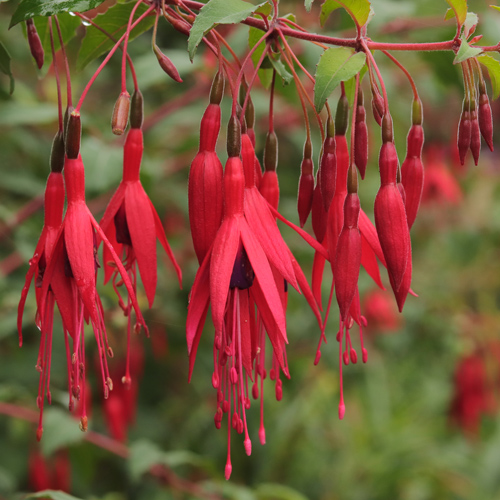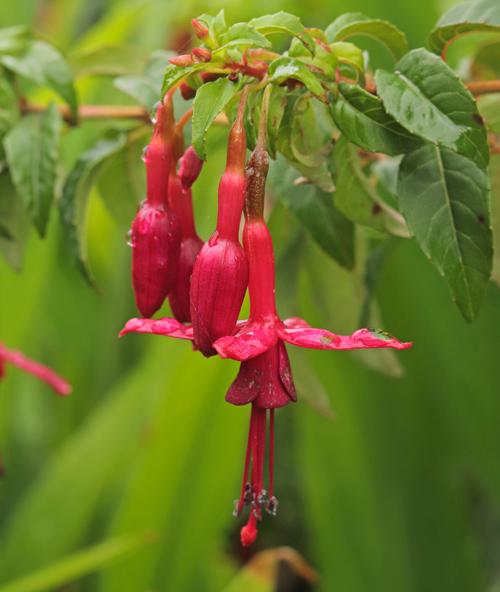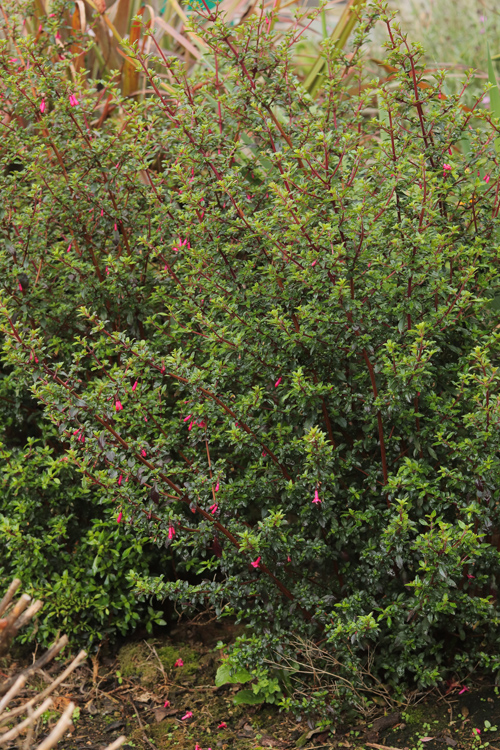 Fuchsias are a terrific group of plants for providing colour in the late summer /autumn period, especially in gardens that are a bit on the shady side. In this garden they have the further great merit of not being touched by slugs. Just need to sort out the capsids. We have a good number, both planted in the ground and grown in pots, on the basis that the hardy varieties are left permanently in the ground while the non-hardies can be moved under protection in winter.
Fuchsias are a terrific group of plants for providing colour in the late summer /autumn period, especially in gardens that are a bit on the shady side. In this garden they have the further great merit of not being touched by slugs. Just need to sort out the capsids. We have a good number, both planted in the ground and grown in pots, on the basis that the hardy varieties are left permanently in the ground while the non-hardies can be moved under protection in winter.
If ever there was a dodgy concept in gardening then it is hardiness. This winter was almost frost free until the beast from the east struck in February. We had a couple of nights below -5°C, with daytime temperatures around 0. The cold spell lasted a few weeks.
We have mostly had very mild winters in the last few years, with little frost. The number of Fuchsias not regarded as hardy that we have planted out has grown. Perhaps something gets planted for the summer and we don’t get around to lifting it, or we have an old plant and we’ve propagated a new younger one, so the old one goes out to sink or swim. In some cases there is little information available and the only way to find out if it is hardy is to leave it out.
Of the supposedly tender varieties in the garden I don’t think we lost a single one last winter. We usually plant them fairly deep, a couple of inches below soil level, and we leave the top growth on until late winter for the protection it affords. F.perscandens and F. x colensoi came through with no top growth die back at all. F. boliviana and F. splendens, which have been in the ground for many years, were as usual killed to the ground but came back up in spring, albeit a little later than usual. If they have not grown as well as hoped it is because of the recent hot dry weather. Among cultivars that by rights shouldn’t have survived are ‘Quasar’, ‘Marlies de Keijzer’, ‘Remember Eric’, ‘Waldis Simon’, ‘Maxima’, ‘Jadi Messingtetra’ and ‘Delta’s Parade’. Usually amongst our hardiest are F. microphylla and ‘F. ‘Rading’s Karin’, both tiny flowered encliandra types. They have come through some recent winters without stopping flowering or dropping a leaf. Not so this year; killed to ground level and very slow to stage a comeback, with flowering still not even starting.

It seems with hardiness that new information or experience merely adds to my ignorance. It would be possible to hypothesize any number of explanations for what we see, but which, if any, is the correct one, and ultimately, how much does it matter. If there is a risk of losing something over winter, we take cuttings and overwinter small plants under cover. If something dies, it is all too quickly forgotten and the space filled with something else.
The range of Fuchsias available in garden centres is very small, with the same varieties offered everywhere. I know a lot of people aren’t keen on them and I know that some of those people would look again if offered some of the species, or species crosses. You’re not likely to see them offered outside of specialist nurseries however and the number of them left is shrinking. There are three National Collections, holding a total of just 284 varieties between them, which considering that the website FuchsiaFinder lists over 17,000, doesn’t seem many. We have 100 ourselves. Here are some that were flowering today.


























That is a lovely collection. It is interesting seeing the variety in flower shape.
LikeLike
There’s a lot more variety than most people realise, especially in the species.
LikeLike
It must be fascinating to walk around your garden, Jim. You have so many plants. I have always liked fuchsias but I don’t grow any here. In Sydney they did very well, as you probably know, but the climate isn’t right here unless you have a shade house or can bring them inside. I enjoyed reading about yours.
LikeLike
One day I’ll master video and do a virtual walk round my garden, it’s defeated me so far. I need a ten year old to teach me.
LikeLiked by 1 person
They are all so gorgeous! Do you attract hundreds of hummingbirds with them as well?
LikeLike
Sadly, we don’t get hummingbirds on this side of the pond. The closest we get is humming bird hawk moths, which is not close at all. If bees can’t get at the nectar because of the long tube, they sometimes cut a hole in the side.
LikeLike
That’s a shame because I know hummingbirds really love fuchsias. I like those moths, though. Have never seen bees cut holes in flower blossoms, although I have seen some that can drill into wood.
LikeLiked by 1 person
Wow! You do have quite a collection. I was going to do a Six on Saturday of my fuchsias this week, but this post puts mine to shame. I probably have the most common ones! I do like fuchsias, they are usually easy to propagate and some of the less hardy ones have survived outdoors even in Shropshire, though I am trying to get a collection of hardy ones to put out on my north-facing ‘patio’. I shall keep coming back to this post and see which ones I fancy. ‘Dying Embers’ and ‘Lady in Black’ are definite must haves!
LikeLike
There are spares of ‘Lady in Black’ if you’re passing, not Dying Embers though you’re welcome to cuttings.
LikeLiked by 1 person